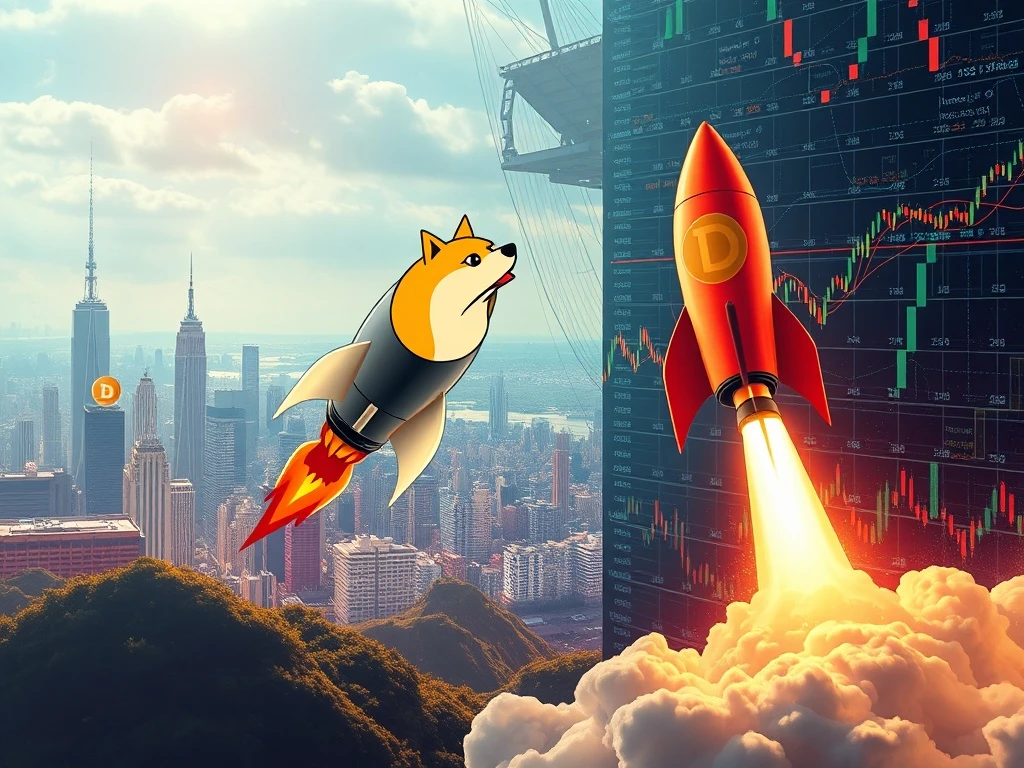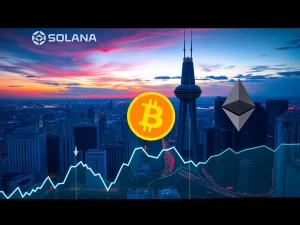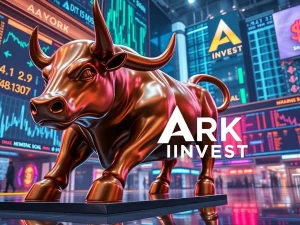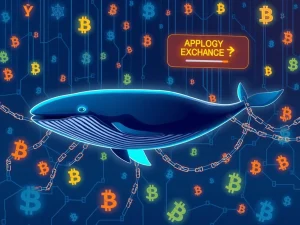Dogecoin ETF: Unveiling a Monumental Shift in Crypto Investment

The cryptocurrency world is buzzing with a groundbreaking development: the launch of the first US Dogecoin ETF. This event ignites a crucial debate across the industry. Many wonder if this marks a significant step towards mainstream crypto adoption or merely formalizes the controversial trend of memecoin speculation. The new fund forces a re-evaluation of how traditional finance views digital assets, especially those born from internet culture.
The Groundbreaking Dogecoin ETF Unveiled
On Thursday, the Rex-Osprey Dogecoin ETF (DOJE) launched in the United States. This marks a pivotal moment for Dogecoin, a cryptocurrency that began as a joke. Unlike previous Bitcoin ETFs, which gained approval under the Securities Act of 1933, DOJE secured its approval under the Investment Company Act of 1940. This framework typically governs mutual funds and diversified ETFs. BlackRock’s spot Bitcoin fund, for instance, directly holds Bitcoin in Coinbase custody. However, DOJE gains its exposure differently. It uses a Cayman Islands subsidiary and derivatives. This structure complies with the 1940 Act’s requirements for diversification, which restricts single-asset concentration. This unique approach highlights the regulatory complexities of integrating diverse crypto assets into traditional financial products. Investors are now closely watching the performance of this new fund.
Traditionally, crypto ETF debuts are celebrated across the industry. Yet, the Dogecoin fund draws sharp criticism. Critics argue that institutionalizing a memecoin promotes speculation. They also point to the fees charged, which investors could avoid by buying Dogecoin directly. Some observers find it ironic that Dogecoin, initially a satire, has reached the ETF stage before many projects with more tangible use cases. This development certainly challenges conventional notions of value within the crypto space. The DOGE price climbed ahead of its US ETF debut, as shown by CoinGecko data. This surge reflects immediate market enthusiasm for the new investment vehicle.
Dogecoin’s Journey: From Satire to Serious Asset
Dogecoin originated in 2013 as a fork of Luckycoin, itself a fork of Litecoin, which is a fork of Bitcoin. It started as a playful jab at Bitcoin’s seriousness. Despite its humorous beginnings, Dogecoin has evolved significantly. It is now a top-10 cryptocurrency by market capitalization. Retail traders have long embraced Dogecoin, fostering a strong community. This success also spawned the broader memecoin category, often criticized for its volatile, casino-like nature. Therefore, its approval for an ETF is particularly controversial. Many question the underlying utility of such an asset in a regulated investment product. The debate intensifies around the legitimacy of these community-driven tokens.
The core question remains: do we truly need a Dogecoin ETF? An ETF allows investors to gain exposure to Dogecoin through the stock market. However, not everyone sees the benefit. Brian Huang, co-founder and CEO of crypto management platform Glider, shared his perspective with Crypto News Insights. “These ETFs are charging off-the-charts fees when you could simply create a Coinbase account in five minutes, buy the token and never be charged an expense ratio,” Huang stated. He further suggested that institutional investors typically prioritize “legitimate” and revenue-generating tokens. This sentiment underscores a fundamental tension between traditional investment principles and the unique characteristics of memecoins. The ongoing discussion highlights varying philosophies within the financial world.
Navigating Memecoin Speculation and Investor Costs
Dogecoin has historically minted millionaires among its early investors. However, its price constantly battles inflation. Dogecoin’s tokenomics were designed as a satire of Bitcoin’s scarcity. Unlike Bitcoin’s 21-million-coin cap, Dogecoin has an unlimited supply. It issues a 10,000-DOGE block reward every minute. This means approximately 5 billion new coins enter circulation annually. This inflationary model directly contrasts with the scarcity narrative often celebrated in the crypto community. Dogecoin pokes fun at Bitcoin fans’ obsession with scarcity, as noted by the Dogecoin Foundation. During past memecoin booms, analysts frequently warned about these assets. They believed memecoins diverted capital and attention from more serious blockchain projects. Some observers view the new ETF as reinforcing this problem. Douglas Colkitt, a founding contributor at layer-1 blockchain Fogo, expressed his concern. “It’s wild to see a memecoin front-run serious projects to the ETF finish line,” Colkitt told Crypto News Insights. He added, “An ETF wrapper doesn’t change the fundamentals; it just lets Wall Street pump DOGE with a straight face.” This highlights a central criticism: the institutionalization of what many perceive as pure memecoin speculation.
The launch of the Dogecoin ETF does not, however, signal a crypto ETF free-for-all. By the end of August, 92 crypto ETPs were awaiting SEC decisions in the US. Dogecoin products were among them, alongside other memecoin applications like Pengu, tied to the NFT brand Pudgy Penguins. Altcoins like XRP and Solana also have pending applications. Mike Maloney, CEO and founder of Incyt, offers a different perspective. “Dogecoin may have started as a joke, but it’s become a serious altcoin that’s brought real investors and engineers into the space,” Maloney asserted. He emphasized that “Community engagement is as real for a coin as it is for a stock.” This viewpoint highlights the power of community in driving crypto asset legitimacy. The US crypto ETP application list continues to grow, as illustrated by James Seyffart’s data. This growth shows sustained interest in regulated crypto investment products.
Community Power Driving Crypto Adoption and Regulatory Shifts
While critics like Colkitt express frustration, others argue Dogecoin’s success reflects crypto’s unique community dynamics. Maja Vujinovic, CEO of Digital Assets at FG Nexus, offered valuable insight to Crypto News Insights. She believes Dogecoin leapfrogging other altcoins demonstrates how communities can push assets into regulated structures. “If DOGE is first, it’s less about technical roadmaps and more about acknowledging that communities themselves can push assets into regulated structures,” Vujinovic explained. She continued, “That’s an important signal regulators are responding to social momentum as much as market cap.” This perspective underscores the evolving nature of crypto adoption. It suggests that grassroots support can significantly influence regulatory decisions. Unlike many altcoins, Dogecoin has frequently been in the mainstream spotlight. Tesla CEO Elon Musk’s tweets in 2021 famously sent its price soaring. A US government department he once led was even humorously dubbed the Department of Government Efficiency, or DOGE. The token has also weathered multiple bear markets. This resilience gives it a level of maturity and staying power that many other memecoins lack. Musk famously called Dogecoin a “hustle” in a 2021 comedy skit on Saturday Night Live, yet his influence remains undeniable.
Vujinovic also clarified that the ETF pathway will not be a “free-for-all.” She emphasized that liquidity, surveillance, and custody readiness still set the bar for approval. However, she predicts that more tokens will find their way into regulated wrappers. This trend, she believes, broadens overall adoption. On Tuesday, the SEC delayed its decision on the Bitwise Dogecoin ETF, extending the review window to November 12. This delay indicates the cautious approach regulators are taking. Each application is thoroughly scrutinized. The SEC’s measured pace reflects the complexities involved in approving novel financial products. This measured approach ensures market stability. It also aims to protect investors from undue risks. The future of institutional crypto hinges on these careful regulatory considerations.
Blurring Lines: Meme Culture Meets Market Innovation
The Dogecoin ETF compels the crypto industry to confront a critical question. Is embracing speculation and culture an inherent part of its evolution? Skeptics argue the new fund leans too far towards the latter. For Brian Huang, the concept of wrapping a single token in an ETF is “ridiculous.” He likens it to packaging a lone stock as a diversified product. To him, the Wall Street wrapper does little more than institutionalize a meme. It also charges investors fees they could easily avoid by buying DOGE directly. This perspective highlights the ongoing tension between financial utility and cultural phenomenon. The debate centers on whether such products genuinely benefit the average investor.
Others counter that form matters as much as function. Maja Vujinovic points out that an ETF does not alter Dogecoin’s underlying code or purpose. Instead, it layers in crucial elements: custody, audits, and disclosure requirements. These additions significantly enhance legitimacy for mainstream investors. This structure provides a sense of security and familiarity. Douglas Colkitt views the development as both a promise and a parody. If a memecoin can achieve a regulated ETF status, then “anything is on the table,” he suggests. This could certainly open doors for broader crypto adoption. However, it also underscores how crypto continues to blur the line between breakthrough financial innovation and pure entertainment. In this sense, DOJE doesn’t definitively answer whether memes belong in serious markets. Rather, it demonstrates that regulators and investors alike are willing to treat them as if they do. This willingness marks a significant shift in market perception. The long-term impact on the DOGE price and broader market remains to be seen. Rex-Osprey has more memecoin ETFs in its pipeline. SEC filings outline products tied to Official Trump (TRUMP) and Bonk (BONK), along with altcoins XRP (XRP) and Solana (SOL). This indicates a growing trend. The market is increasingly exploring diverse crypto-backed investment vehicles. This development further solidifies the role of community and cultural impact in shaping financial products.








